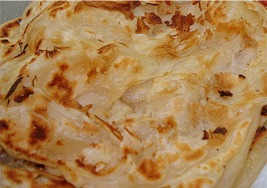Gothamba Roti - Veechchu roti

Gothamba Roti
This Gothamba roti is an imported dish from Malaysia where this is a type of flat bread made of wheat flour and is known as Roti Canai or Roti Chanai. In those days this was available mostly in Malay restaurants or eating houses but now it is widely available and is a common dish in Yarlpanam. Roti Chanai is believed to have been brought to Malaysia by the migrant workers from Madras or Chennai. Canai in Malay means ‘to knead'. In English Roti Canai is often referred to as ‘flying bread' a term meaning the process of tossing and spinning by way of which it is made. It is called Veechchu roti in Tamil due to the way it thrown about to make it thin.
This is a dish that can be eaten at breakfast, lunch or dinner and even as a snack. In Malaysia this is served 24 hours a day and is also a favourite midnight snack. It is also consumed as an appetizer in Malaysian restaurants.
There is another very similar dish - Parotta from India which is discussed later.
Recipe for Gothamba Roti / Roti Canai / Veechchu roti
This is composed of flour, water and fat of some kind usually ghee or clarified butter or vegetable oil
Ingredients:
Flour 280 Gms
Clarified butter /ghee / vegetable oil as needed
Water as needed
Salt to taste
Method:
Sieve the flour and salt into mixing bowl.
Mix the ghee / oil first and add water and keep mixing until the dough is of smooth medium and non sticky consistency.
Cover the bowl with wet cloth and allow it to rest for 3 hours to soften.
Then the entire mixture is kneaded well, flattened, oiled and folded repeatedly. This is then allowed to rise further for 20 minutes.
Repeat the process of folding and kneading.
Finally the dough is divided into many dough balls of the size of golf balls or little larger, dipped in oil and left under a wet muslin cloth cover to prevent it from drying.
Then each ball is taken out, flattened on an oily platform and spread out first by hand and then by a gentle process of spinning and tossing to make it as thin as possible.
Alternatively you can roll into a thin sheet and pull at its edges to stretch out and become thin.
Then the edges are folded to form a big square (about 10 inches).
This is then cooked on flat iron skillet with oil spread on it.
This is fried on both sides to make the process complete.
This is ‘roti tisu' or tissue bread and it is known as Veechchu roti in Jaffna. The names reflect the process of spinning and spreading the roti. The act of spinning and tossing is a process you can watch with amazement and it is an art which you will have to learn.
This can also be made round without spinning and tossing but flattened to a round form and frying on the skillet.
Serve with: Traditionally it is served with dhal curry or meat curry.
Variations:
1) With fried eggs -
While the roti has been spread out on the skillet, break an egg and spread over it. This will cook and when you turn over the roti it will get well cooked with the roti.
2) Kothu Roti - Click here
Demo Video:
It is sometimes difficult to understand from the description how to make this item, so we give you a link to see a demonstration video:
This is an external link given for your benefit only; please read Disclaimer page.
http://www.youtube.com/watch?v=3EucCu1zafk





